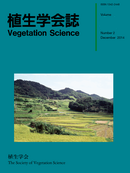Quercus serrata secondary forests are one of the most typical coppice woodland types in Japan. They had been maintained as a source of fuel, manure and material for various uses until the late 1960s in Japan. However, for the last 30 years, most of them have been abandoned, and without regularly cutting and clearing changes in plant species richness and composition have occurred. In this study, we observed changes in the species richness and composition in two major types of Quercus serrata communities (Quercetum acutissimo-serratae Miyawaki et K. Fujiwara 1968 (QA) and Castaneo-Quercetum serratae Okutomi, Tsuji et Kodaira 1976 (CQ)) in Kanto region, Central Japan by revisiting 113 old plots investigated from 1974 to 1980 (SI). Seventy-five plots out of 113 plots (66.4%) remained as Quercus serrata forests in our follow-up survey from 2000 to 2001 (SII). The remaining rate of CQ plots (75.0%) was larger than that of QA plots (60.0%). Species richness (number of vascular plants per plot) in SII is not significantly different from that of SI. Species richness in each plot is significantly related to Pleioblastus chino cover and evergreen trees cover including Pleioblastus chino in QA, and management condition in CQ. Change of QA's species composition from SI to SII is significantly larger than that of CQ. Compositional change in each plot is significantly related to woodland proportion of the municipality where each plot is located in QA, and slope degree, litter cover and evergreen trees cover in CQ. Most of decreasing species from SI to SII were anemochory while increasing species included a lot of zoochory (mainly endozoochory). Increasing species from SI to SII include a lot of garden or greening plants probably dispersed by birds from nearby streets, parks and cemeteries. Those plants significantly increased, especially in fragmented forests in urban areas where population densities rose considerably from SI to SII. In order to manage Quercus serrata forests appropriately, long-term changes in species composition as well as species richness need to be monitored in consideration of the locational conditions surrounding the forests on a regional scale.
View full abstract
